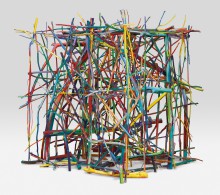Agnes Martin
Untitled #21 1980

© 2014 Agnes Martin / Artists Rights Society (ARS), New York. Reproduction, including downloading of ARS member works is prohibited by copyright laws and international conventions without the express written permission of Artists Rights Society (ARS), New York.
Spirituality and the Ethics of Inspiration
Agnes Martin believed one could see perfection in the mind but that painting it was impossible. The meticulously ordered but quiveringly drawn graphite lines in Untitled #21 construct long, narrow rows of color, each fading to white as you approach the painting, and hardening as you step back.
Biographers have noted the depth with which Agnes Martin studied Christian mysticism and Buddhism. Scholars are quick to draw relationships between her spiritual practice and her painting. For Christian influence, one might see the practice of decreation in which a person casts off her ego so God may inhabit her being. The radically austere lines in the painting required a selfless discipline. For Buddhist influence, one might see in Martin’s painting, whose pointed simplicity is clear and direct, the prominent Buddhist teacher Daisetsu Suzuki’s conception of the “beginner’s mind,” which, in its innocence, sees clearly. How might one distinguish between these influences? What is the use of identifying the spiritual tradition that influences painting?
—Callum Tresnan ‘23







